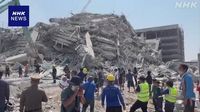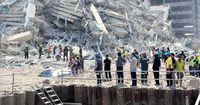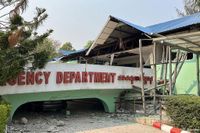On March 28, 2025, a powerful earthquake struck central Myanmar, registering a magnitude of 7.7, as reported by the U.S. Geological Survey (USGS). The quake occurred at approximately 0:50 PM local time, which corresponds to 3:20 PM in Japan. This seismic event not only rattled Myanmar but also sent strong tremors across the border into Thailand, particularly affecting its capital, Bangkok.
About 12 minutes after the initial earthquake, a secondary quake was recorded with a magnitude of 6.4, compounding the concerns of residents in both countries. Reports indicate that the epicenter was located near Mandalay, Myanmar's second-largest city, at a depth of roughly 10 kilometers.
The Myanmar military has declared a state of emergency in several affected regions, including Mandalay and Sagaing, where multiple buildings have collapsed. Local media outlets have reported casualties, with the New York Times citing a doctor who confirmed that at least 20 people have died and over 300 have been injured in Mandalay alone.
Eyewitness accounts from Mandalay describe scenes of chaos. A 39-year-old woman recounted, "My apartment shook violently, and everything fell over." She noted that internet and electricity services were disrupted in the city, further complicating the response efforts. Additionally, images released by the BBC showed a large bridge collapsing into a river, highlighting the extensive damage caused by the quake.
In the capital, Naypyidaw, similar devastation was reported. Roads suffered significant damage, with large cracks appearing, and buildings were seen crumbling in various locations. The Myanmar military has called for urgent blood donations to assist the many injured being transported to hospitals.
As the situation unfolded, the chaos extended into Thailand, where the tremors were felt strongly in Bangkok. Reports indicate that a 33-story government building under construction collapsed, trapping approximately 83 workers inside. Thai authorities have confirmed that at least three people have died in the aftermath, with more than 100 individuals reported missing. Rescue operations are currently underway to locate those trapped beneath the rubble.
In response to the crisis, Thai Prime Minister Srettha Thavisin declared a state of emergency in Bangkok, allowing the government to mobilize resources more effectively. Public transport, including elevated and underground trains, was halted, and hospitals began evacuating patients to ensure their safety. Footage from public television PBS showed the alarming scene of a building collapsing within seconds, with workers fleeing in panic as dust engulfed the area.
Residents in Bangkok described their experiences during the quake. A 40-year-old business owner reported feeling a strong tremor in his high-rise office, where lighting fixtures cracked and debris fell. He canceled a scheduled employee interview, opting instead to evacuate with his daughter to a nearby office.
The earthquake's impact has raised significant concerns about the humanitarian situation in Myanmar, which is already experiencing turmoil due to ongoing civil conflict between the military and resistance forces. The Myanmar military has made an unusual appeal to the international community for humanitarian assistance, indicating the severity of the situation.
In light of the disaster, both the Japanese embassies in Myanmar and Thailand have reported no injuries among Japanese nationals as of the evening of March 28. However, many Japanese companies operating in the region are taking precautionary measures. For instance, Nissan Motor temporarily suspended operations at two factories near Bangkok to assess any potential damage and prioritize employee safety.
Other Japanese businesses, such as Aeon, which operates supermarkets in Myanmar, reported no damage but have temporarily closed some stores for inventory reassessment. Meanwhile, Ajinomoto, a major food manufacturer, is confirming the safety of its employees at its seasoning factory in Myanmar, and Yakult Honsha has suspended operations near Yangon but confirmed the safety of its staff.
As the rescue and recovery efforts continue, the full extent of the damage and the human toll remains uncertain. Both Myanmar and Thailand are bracing for further aftershocks, which could complicate ongoing rescue operations and exacerbate the already dire situation.
In summary, the earthquake that struck central Myanmar has had devastating effects, not only in Myanmar but also in neighboring Thailand. With reports of casualties and extensive damage, the focus now turns to rescue efforts and the international response to this natural disaster.










